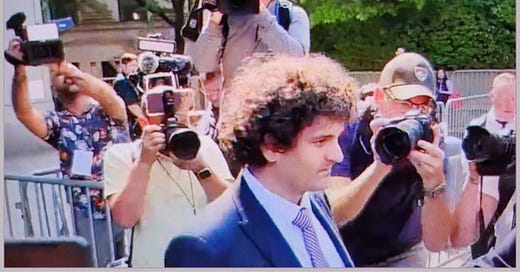EXTRA: Bankman-Fried 2d Cir Appeal Brings Internet and First Amendment Qs, You Make Your Bed - analysis here
More including analysis here below the fold / paywall line
by Matthew Russell Lee, Patreon Book Substack
SDNY COURTHOUSE, Sept 19 – Sam Bankman-Fried of FTX on August 11, 2023 for tampering with witnesses in the upcoming trial against him was ordered remained to jail.
U.S. District Court for the Southern District of New York Judge Lewis A. Kaplan heard from prosecutors that in Putnam County Correctional Facility, SBF could be given access to discovery material over the Internet.
Kaplan replied that he assumed the defendant would be in the Metropolitan Detention Center in Brooklyn, like fellow crypto-fraud defendant Miles Guo and others.
On August 12 Inner City Press, which published the first book about SBF's remand ("Crypto Creeps," here, sample on Substack here) found the Bureau of Prisons notice, listing SBF in the MDC.
On September 19, SBF's appeal of remand was heard by a Second Circuit three judge panel. Inner City Press live tweeted, thread here:
SBF's lawyer: The District Court erred in saying the 1st Amendment was not applicable. He was communicating with the New York Times
Judge: Is there a right to intimidate a witness? SBF's lawyer: No, but -- Judge: There's a finding he leaked to intimidate a witness
SBF's lawyer: There is a misapplication or misunderstanding of the law --
Judge: If there is an obstruction or attempt to intimidate, the First Amendment has no play anymore. SBF's lawyer: But Judge Walker, the First Amendment is part of the analysis.
Judge 2: It cannot be that a subjective belief is enough.
SBF's lawyer: I'm not saying that. But if it is protected to speak to a reporter, which it is, if it is protected to defend oneself, which it is--
Judge: The First Amendment protect speaking to anyone Judge: You said you had three points. What are they?
SBF's lawyer: They're about least restrictive alternatives. The Bail Reform Act favors release. There was an alternative in place --
Judge: But the District Court reached the conclusion it wasn't working SBF's lawyer: There had been one prior incident. What was before the court was the contact with the New York Times reporter. The condition could have continued. My last point is that the court did not consider the 6th Amendment, we have a trial Oct 2
[No, Oct 3]
SBF's lawyer: Our client needs Internet access, he only has it in the cell block.
Judge: Where is he being held? SBF's lawyer: The MDC. We were with him last week, in one hour he could call up one document. Judge: You have one minute rebuttal. Ms. Sassoon?
Judge: Ms. Sassoon, can something be done about that Internet? AUSA Sassoon: I'm Danielle Sassoon and I represent the goverment. The 6th Amendment is not properly considered here. Judge: Is the idea to bring the Internet into the MDC?
AUSA: That is not permitted. He can be produced to the cell block twice a week. There have been some issues with the Internet. He has 7 experts, he had 7 months before remand. Judge Kaplan found no 6th Amendment issue.
Judge: We are in charge on release. But Judge Kaplan has it over the Net AUSA Sassoon: Judge Nardini, you were asking about the violations when he was out.
Judge Kaplan did not err. Mr. Cohen focused on the NYT, but there was Witness-1, the defendant reached out to a potential trial witness, saying let's be constructive
AUSA Sassoon: The incident with Ms. Ellison shows an intent to interfere with a fair trial. The judge was correct to say the 1st Amendment had nothing to do with it. It was tampering. Counsel does not dispute that the content put Ms Ellison in an unfavorable light
Judge: Discrediting is not witness tampering, right? AUSA: It was private journal entries. Judge: Publicly humiliating could be viewed as a way to try to intimidate, to dissuade from testifying as strongly or at all. And to intimidate others.
AUSA: Here you have more than an effort to discredit. It was the manner in which it was shared, anonymously and covertly. He had the reporter come to his house and view the material on his computer. Judge: So it was covert AUSA: He was trying to cover his tracks.
AUSA: There is also the timing, when Ms. Ellison is poised to testify. Also, he instituted auto-delete policies of evidence. On least restrictive, Judge Walker, the court gave a number of opportunities. Judge: OK, 1 minute of rebuttal, Mr. Cohen Cohen: 58 seconds.
SBF's lawyer Cohen: Experts don't substitute for sitting with your client. Judge: The government has every incentive to help- they don't want an issue on appeal, if there is a conviction. They seem to be doing that. SBF's lawyer:
Judge Walker, it's not happening SBF's lawyer Cohen: The Internet is so slow as to be useless. Judge: Your client should have thought of that. He makes his own bed, he sleeps in it. SBF's lawyer: But what about least restrictive. SBF's lawyer: To to over my 58 second. This was not covert.
SBF's lawyer: The reporter signed in. When you look at revocation cases, it was one encounter, in Lafontaine the facts were more extreme. We ask you to reverse.
Judge: Thanks. We will take the case under advisement
More including analysis below the fold / paywall line here
Keep reading with a 7-day free trial
Subscribe to Matthew Russell Lee’s Newsletter to keep reading this post and get 7 days of free access to the full post archives.



